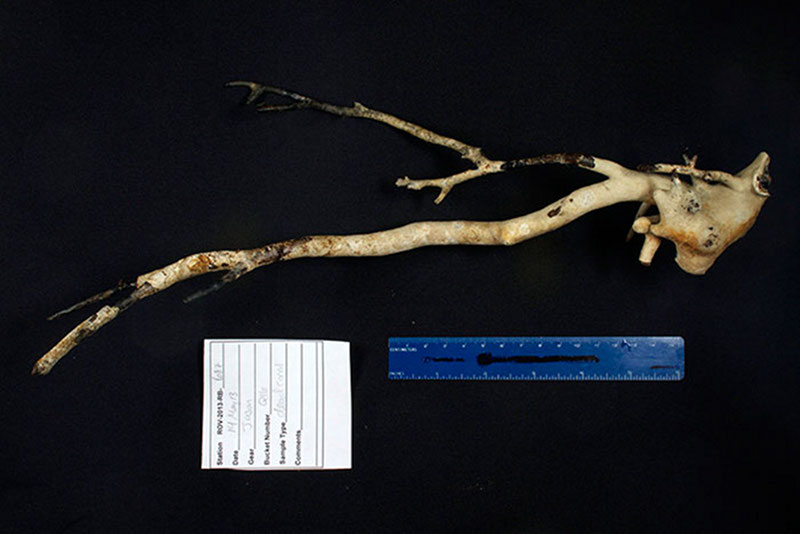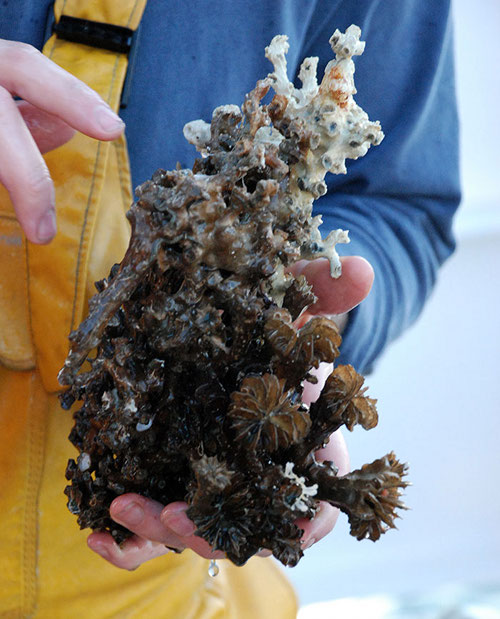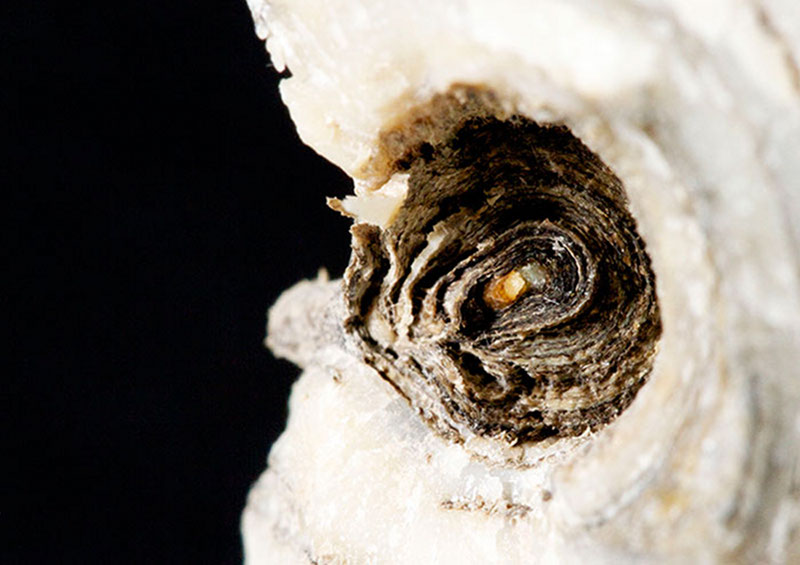
By Brendan Roark, Assistant Professor - Texas A&M University
Nancy Prouty, Research Oceanographer - U.S. Geological Survey
May 16, 2013

A black coral growing on a vertical wall in Norfolk Canyon. Black corals are named for the color of their skeleton, while their tissues take on vibrant hues ranging from red to yellow or white. One family of black corals, Leiopathes, has been found to survive over 4,000 years, making them among the longest-lived organisms on the planet. Image courtesy of Deepwater Canyons 2013 - Pathways to the Abyss, NOAA-OER/BOEM/USGS. Download larger version (jpg, 8.2 MB).
While most of our colleagues are searching for brightly colored corals and mysterious microscopic bacteria, we (Brendan Roark -Texas A&M and Nancy Prouty-USGS) seem to be the only ones to jump to our feet when the remotely operated vehicle (ROV) stumbles upon a dead-looking skeleton peaking out from the fine silt-sediment.
Yep, we are akin to a hagfish, scavenging the sea bottom and ROV quivers for dead corals and accepting the discarded skeletons from the biologists. But we are all smiles!

A coral skeleton, likely Primnoa, collected by Jason and photographed in the wet lab. Its branching pattern and growth structure resemble that of trees on land. Image courtesy of Liz Baird, Deepwater Canyons 2013 - Pathways to the Abyss, NOAA-OER/BOEM/USGS. Download larger version (jpg, 5.6 MB).
Why the smiles? Why the jubilation? Basically, every skeleton we collect on this cruise provides a window into the past. Like a puzzle piece, each coral specimen contributes to our understanding of how climate and the environment have varied in different parts of the world and at different times.

A cluster of two species of deep-sea coral skeletons grown together: the thin branched top is likely Solenosmilia while the circular bottom ‘cups’ are Desmophyllum. The dark green dead skeletons can support live coral (white), and provide scientists a timeline of growth that can span decades. Image courtesy of Deepwater Canyons 2013 - Pathways to the Abyss, NOAA-OER/BOEM/USGS. Download larger version (jpg, 4.9 MB).
To study past variations in climate, we will look at the biological, geological, and chemical characteristics of the skeletons of deep-sea corals recovered from Baltimore and Norfolk Canyons in the mid-Atlantic. In general, studies utilizing these organisms have been based on samples recovered in dredges and hauls. However, using remotely operated vehicles, such as the Kraken II and Jason II, allows us to do selective sampling as well know exactly what kind of environment the coral lived in in order to gain a better understanding of their living environment.
One reason deep-sea corals may be excellent recorders of past climate changes is that they fill a gap between tropical corals (surface water from the tropics) and the foraminiferan records from ocean sediment cores (surface and bottom water) in that they record both surface and intermediate water variability on different time scales.
Deep-sea corals occur in all the world's oceans, at depths ranging from nearshore to 6,200 meters and in water temperatures ranging from 4 to 29°C. The highest population density of deep-sea corals occurs between 500 and 2,000 meters (e.g. intermediate waters), including a large and diverse distribution along the canyon walls of the mid-Atlantic region.

Close-up of the above coral branch, showing a cross-section of its growth bands. At very high resolution, one can count these annual growth bands to determine age. This particular species deposits both a carbonate (light) and proteinacious (dark) material to form its skeleton. Image courtesy of Liz Baird, Deepwater Canyons 2013 - Pathways to the Abyss, NOAA-OER/BOEM/USGS. Download larger version (jpg, 5.6 MB).
A secondary objective of our study is to document the longevity of these deep-sea macrofauna. Gigantism and longevity (“big and old”) are common biological adaptations in deep-sea fauna. Our own research on deep-sea macrofauna, including stony corals and proteinaceous zooanthids, indicates that some individuals live for centuries to millennia – they are the "old-growth redwoods" of the deep ocean. The fact that these individuals live for such a long time means that we can use them to reconstruct past variations in ocean circulation and surface ocean productivity, in the same fashion that we can reconstruct climate variability from tree rings.
These large, deep-sea fauna have even more in common with old-growth redwoods: They provide habitat for what would otherwise be a much less diverse group of deep-ocean organisms (biota). Deep-sea corals take a long time to grow large and are threatened by indiscriminate human activities such as trawling and dredging.
We wonder, what will happen to these organisms and the deep-sea ecosystems they support as people grapple with climate change, how to curb carbon-dioxide emissions the world over, as well as how to manage and protect our marine resources in areas where human activities also occur?